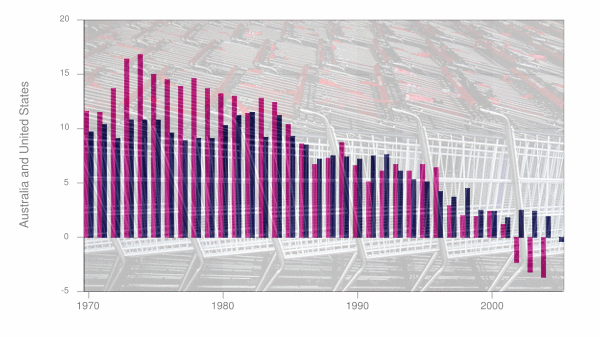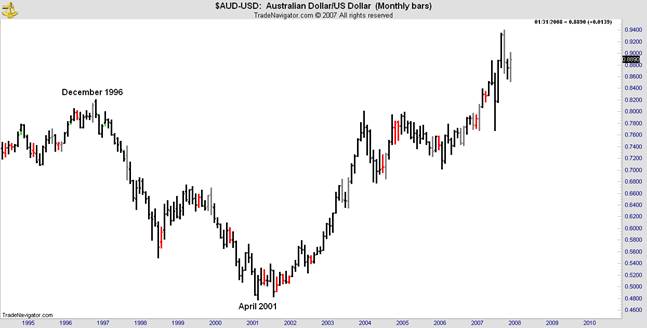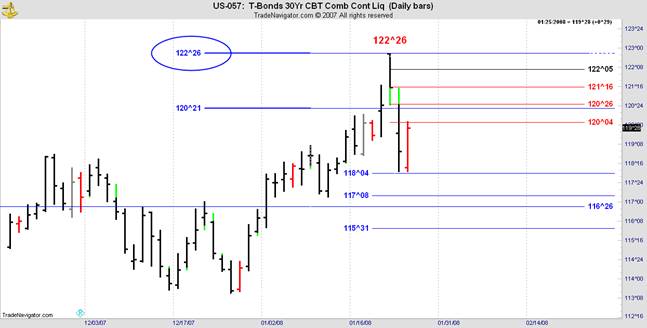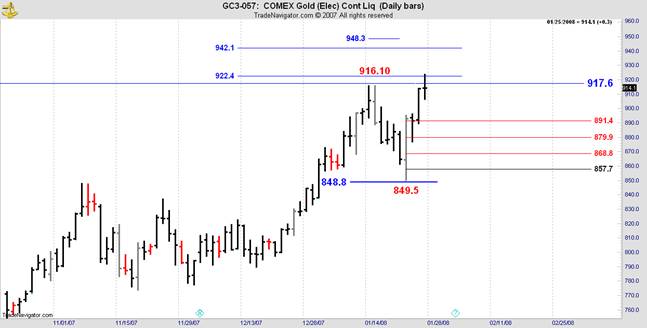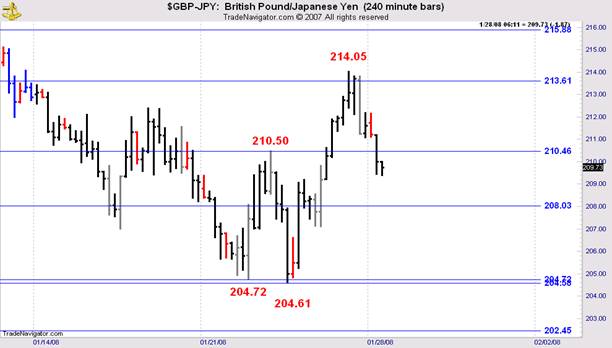The story so far
Being hit by a bus is usually an act of fate which with hindsight can be seen as avoidable. Standing in front of a bus on a dark, rainy night and watching it barrel down the highway towards you at high speed is an act of either suicide or stupidity. It doesn't happen often yet this is precisely what is happening to the great housing bubble Down Under!!
The common factor in all notable financial catastrophes is that they seem to be of the "OOPS-Sorry" variety, which is explainable if not understandable by sober persons after the act. To see and understand the imminent catastrophe before it cracks is a rare opportunity.
Long Term Credit Management had an oops-sorry episode when it turned out that the Nobel Prize winning Scholes-Black pricing formula for vanilla options (nothing to do with ice cream folks), had a problem. The problem was that it didn't actually work as advertised. Mortgage backed securities are still having their oops-sorry moment. We now know that those AAA ratings didn't actually mean what they said.
The most charitable spin that can be put on these fiscal failures and a thousand like them is what is known in Australian legal circles as "The Streaker's Defense". Streaking seems to be a peculiarity of sports lovers down under although it undoubtedly happens elsewhere. The usual scenario is that after a lengthy time sitting in the blazing sun drinking warm beer and watching cricket (a cricket test match can last for 5 days), the observer notes that 1) he or she is hot, 2) he or she is thoroughly bored and 3) he or she needs some exercise after sitting on the "hill", (an earthen mound with no seats) for half the day. At this stage our streaker sheds their clothes, jumps the boundary fence, and "streaks" across the playing field vigorously pursued by an elderly minor official or sometimes a member of the constabulary. Usually the streaker will run over to say "Gidday" to his or her favourite player before being captured, charged with indecent exposure and arraigned before the Magistrate's Court next day.
Inevitably the streaker's defense when fronting the Magistrate next day is: "It seemed like a good idea at the time your Honour!" Unlike streakers, the designers and purveyors of toxic mortgage backed bonds are happily counting their egregious bonuses, lamenting only that this particular party is over. If they are ever unfortunate enough to come face to face with an erstwhile client who actually purchased those AAA bonds they would do well to remember that when nothing else can be said, the streaker's defense is always handy.
Unlike these oops-sorry moments, the great Uridashi Rort is continuing in the bright light of day! "Rort" is Aussie vernacular for trick, con job or getting an improper benefit; not even dictionary.com is up to speed on this wonderful word. It is often used about politicians' perks as in "What a rort" or "They're rorting the system". No other word will do to describe the Uridashi trade.
To get you up to speed on the impending disaster you need to read "Yarns from Down Under-Part 1" in my FSO archives, but the quick version is that the Australian and New Zealand housing bubbles are arguably the greatest bubbles of all time, with the OECD classifying Australian housing prices as the world's highest.
Getting up to date
If you think this is a story of bygone days, think again. The bubble at least in the residential sector is alive, well and accelerating. If you are a Californian house flipper currently lamenting the lack of action, come on down to Melbourne. You'll feel right at home as the respected Australian Property Monitors on Friday 18th January fronted the evening news cameras to proclaim that Melbourne house prices had increased 25% year on year and continue to strengthen! Their outlook for future prices was optimistic. The TV report interviewed a number of young buyers who were camping out overnight at a newly released subdivision, hours from nowhere in the hope of being one of the lucky ones to secure a 542 square meter site on the following day. For those of you unfamiliar with metrics, these sites are 0.1339 of an acre, or 7.5 building sites to the acre!
Myths
The current Australian myth is that Asian growth, in particular China, a major Down Under trading partner, will cushion Australia from any US slowdown. The New Zealand myth is that housing prices never go down and "she'll be right mate"! Unfortunately these hopes by my ever optimistic countrymen are factually wrong. As usual math will prevail over hope.
All bubbles come to an end eventually. What we are interested in here is what will be the catalyst to burst the greatest bubble of all time. We know that avarice and greed in the human species have no bounds so the bubble party won't end from dissipation of buyer demand. Our recent history is not so much "If you build it they will come" as "If you let them they will spend". Thus for reasons peculiar to Australia and New Zealand, it will be the lenders who will end this party and the lenders are not who you think.
Mortgage funding 101 says lendable funds in countries running unsustainable current account deficits comes from i) savings and bank deposits and ii) European and US loans. For the particular circumstance pertaining in these Southern lands we must add iii) URIDASHI!
Savings and Loans
We know that this source of funds was tapped out long ago. Aussies are even more profligate than their American cousins.
The Australian/US level of savings is shown in the graph below. Despite successive governments of various hues, the results have been the same. "Shop till you drop". Aussies, at least in this regard have lead the way as their national savings went negative as early as 2001 and that trend has continued unabated.
Sources: OECD Factbook 2007: Australia (purple) and the U.S. (blue) have seen sharp declines in net savings rates over the last 25 years.
So there is no joy here. Savings were tapped out long ago.
European and US Packaged Loans
The tip of the iceberg on unwanted mortgage bonds, CDOs and their ilk has already been felt in corporate Australia and New Zealand. With A billion in magic paper shuffling there is a big gap to fill.
Jan. 18 (Bloomberg) -- Asset-backed bond sales in Australia may almost halve this year as investors baulk at buying large amounts of debt tied to mortgages, according to Fitch Ratings. Bond sales linked to Australian assets may fall to A billion (.3 billion) this year fromA.8 billion in 2007.
There are a number of casualties of the collapse in the short term Commercial Paper market including publicly listed RAMS Home Loans and Centro Properties. Other debt problems that you know about are visiting our shores as AMBAC the beleaguered US monoline insurer, is among the US guarantors supporting billion of company debt in Australia, according to National Australia Bank on 24 January.
We can assume that the global repricing of risk has effectively ended or at the least neutered the A billion Australian asset backed debt market.
URIDASHI!
That leaves us with the Uridashi trade. New Zealand has a population of 4 million against 20.5 million for Australia. This ratio will become important as we try to unravel the intricacies of this little known piece of financial engineering. Also important is the fact that the four big Aussie banks are also the four big Kiwi banks. Incestuous? You bet! Whilst Aussies and Kiwis hate to be mistaken for each other, the economic reality is that they are intertwined. Each country offers visa free entry and residence to the other and CER (Closer Economic Relations) legislation effectively meshes the two economies. Auckland, the commercial hub of NZ is closer to the main Aussie centers of Sydney and Melbourne than many of the Australian state capitals. The dividing Tasman Sea less than 3 hours across by plane is euphemistically called "The Ditch".
Uridashi is simply the Japanese word for bond but it has acquired a special significance for southern financiers. The Reserve Bank of Australia is conspicuously silent on the Uridashi trade. Its website indicates that Japan is a relatively small player in the Australian foreign exchange picture:
RBA acknowledges the carry trade in this quote from its January bulletin "The Australian Foreign Exchange and Derivatives Markets" at the RBA website.
With Australia maintaining positive interest rate differentials relative to most of the major economies over recent years, the Australian dollar has remained a prominent currency for carry trade activity.
But it apparently doesn't happen with Japan the most notorious contributor to the carry trade. Now that's kind of strange don't you think? With Japanese interest rates hovering from 0 to 0.5%, it seems strange to this humble country lawyer that all of the leveraged carry trade in AUD is supposedly done in AUD-USD at 45% of turnover while AUD-JPY is effectively non-existent at 1%.
Across the ditch in NZ, same banks, closely coordinating with Australian Treasury we have an entirely different deal! Here the Uridashi story is huge. The Reserve Bank of New Zealand is a positive font of information with regular bulletins on NZ's Uridashi exposure. Search Uridashi on RBNZ's website and you will get 50 separate articles. This topic is very much on the mind of NZ's cenrtral bank. I suggest that you read their excellent website at https://www.rbnz.govt.nz, the source for the material that follows.
First, the RBNZ introduction from its 2/12/05 Memorandum titled "Recent NZD Uridashi Bond flows."
Introduction
Offshore New Zealand dollar denominated bonds are typically issued by a non-New Zealand borrower, to investors based outside New Zealand. The bonds are often listed on a foreign stock exchange and are usually sold in small "retail" parcels (as low as ,000). These bonds have been issued in the Japanese market (Uridashi).
Recent issuance of offshore Australian dollar bonds has followed a similar pattern, but at a rate about half that of New Zealand dollar bonds relative to GDP. The value of Eurokiwi and Uridashi bonds outstanding is now larger than New Zealand government bonds outstanding and on par with total New Zealand dollar government securities on issue. Notably, 95 per cent of Uridashi have been issued for two or three year terms.
The rationale for offshore New Zealand dollar bonds
There are two borrowers: a New Zealand household or firm wishing to borrow New Zealand dollars through a New Zealand bank, and a highly rated foreign entity (the Uridashi issuer). There are two sources of funds: the international capital market (foreign currency funding) and foreign investors who are willing to hold New Zealand dollar assets.
A more current picture emerges from the RBNZ Financial stability report 2007:
- The ongoing housing boom and large savings deficit in the household sector are being funded by international borrowing via the domestic banking system. While global markets are currently very liquid, this will not always be the case; the longer imbalances run, the more likely we are to see a sharp correction.
- Financial indicators suggest that banks are managing the risks associated with their individual portfolios adequately. However, it is not clear that banks are taking appropriate account of the systemic risks associated with the rapid growth in their aggregate lending.
- Household debt increased by 10 percent in real terms over the year to December 2006, and now stands at approximately 160 percent of household disposable income. In nominal terms, household debt is over 0 billion.
- To put house prices increases into perspective we look at historical house price developments in New Zealan and in other countries. The largest inflation-adjusted fall in New Zealand house prices occurred in the 1970s, when inflation adjusted house prices fell by nearly 40 percent.
What! Shock, horror! You mean house prices can actually go down as well as up? Now that"s going to be a big surprise to a lot of folks. Strong words from a central bank.
The next two charts set out the immensity and the trick in the Uridashi trade:
Uridashi as Bubble Buster
Uridashi issuance outstanding in the tiny little country of NZ is north of billion. Compare this with Australia's 2007 asset backed bond sales of billion. Uridashi issuance is largely for 2 year periods so on an annualised basis we can make a rough estimate of 50 asset backed debt issuance for every man, woman and child in Australia against 25 per head in Uridashi debt in NZ.
Let us assume that debt funding, like water flows through the easiest, most efficient channel. In regional terms, Australia is a giant. I told you in Part 1 of the huge mineral and gas boom in Western Australia. Now in a country roughly the size of the continental United States, think about the infrastructure costs in Australia. They are massive! Think also of the ease of issuance of asset backed bonds in 2005-2007 Australia. AMBAC happily put their hand up for at least billion and Fitch was estimating billion in 2008 for home mortgage bonds alone. The assumption here is that if there was demand for debt it was issued.
In contrast NZ is largely a rural economy with only one major commercial city. So why is NZ's indebtedness nearly 3 times that of Australia? If you factor in the cost of Australian development and infrastructure, it is more like 10 or 15 times Australia's indebtedness.
Look at the pretty colored chart above. Why is all this Uridashi debt being issued in NZD and relatively little in AUD? On a population and asset backed basis the ratio is approaching 20:1 and that is inverse to the ratio one would expect.
Here are the final pieces of the puzzle. Both Australia and NZ have maintained relatively high interest rate regimes but they are bracketed in close proximity to each other. Both countries central banks acknowledge that their currencies are heavily involved in the carry trade. As the Uridashi issuer is a highly rated supranational we can assume borrowing rates around the Japanese bond rate, let's say 0.75%. The average AUD and NZD mortgage rate in the past 3 years has been 7-8%. The average interest on retail Uridashi bond has been 2.5-3.5%. Between the issuer and the retail user, the hapless Aussie and Kiwi home buyer there is a big fat present for someone and it is not the citizens of these countries.
Why would you suppose this obviously lucrative trade was so attractive to Kiwi banks and largely ignored by Aussie banks. They are one and the same? The incentives of different countries' tax regimes are apparent.
NZ Treasurer Michael Cullen is well aware of this predicament. He has railed against the issuers constantly. From the 2 October 2006 Danielcode Report:
"I think someone would have to be slightly strange to take a bet on the NZ dollar right now," Dr Cullen told the London-based Financial Times.
Just how badly do we have to do on the current account before (investors) notice?"
Meanwhile, Reuters said an expected decline in New Zealand's interest rates coupled with a threat of a massive sell-out by Japanese mum and dad investors next year made a steep fall in the kiwi dollar look all but certain. (Reuters)
Reuters, got it wrong in the final paragraph above, but they touched on the linchpin, what I call the joke of this whole farce. The Japanese punters are bearing the whole of the exchange risk in this perilous adventure of buying into relatively small currencies at times of historically very high exchange rates. This issue has been simmering in NZ for years. Fran O'Sullivan a leading columnist with the NZ Herald put it this way in early 2007:
Uridashi NZ dollar issues are still being arranged in Tokyo this month, despite the efforts by Treasury Secretary John Whitehead and his Reserve Bank colleagues to alert top Japanese officials ... to our emerging economic problems or, as Cullen put them in last week's statement, to ensure the risks of investing in Uridashi NZ dollar bonds were well understood at this time...But it is clear that exerting moral suasion on global institutions is a difficult task. They basically get to clip the ticket when they swap the funds raised from Japanese investors with trading banks after cheap money to lend at significant profit to their clients.
The unspoken issue here inferred by Cullen and tangentially raised by Reuters is that this trade rolls along only so far as new issuance roughly approximates maturities. With the amounts involved for a small economy there are real concerns over fiscal stress levels if issuance subsides. The maturities in 2008 are large. Are the Australian parents guaranteeing their NZ subsidiaries obligations? The clear inference from the Uridashi/currency distribution chart above is that much of this borrowing in NZ is for others.
All the elements of a world class rort are here. Cheap borrowing to lend at gruesome multiples to hapless home buyers; international tax tricks to optimise profit; layers of intermediaries to obscure the paper trail; highly regarded international names to give a gloss of respectability; someone else to take the exchange risk and unlimited incentive to keep the house buying party going, going, going.
Home loan interest rates went up to 9.6% last week in Australia and NZ. This makes the rort so much sweeter but it also foretells the harbingers of doom. At some point the 8 times earnings equation for house prices is going to break. At some point even the elasticity of endless financial innovation will snap. The cycle of successful sellers moving up market will end as the supposedly limitless supply of cheaper house buyers becomes another fat tail on the Bell distribution curve.
This time it will start as a currency issue. It will happen too fast for our Japanese friends who have been so bountiful with their largess.
If you bought NZ Dollar assets in the past 12 months your buffer is gone. At the Danielcode we know a great deal about this all important cross rate. We have picked every move in the past 3 years. Change of sentiment here can be fast and furious! As early as 2006 RBNZ warned that the currency was at "exceptional levels".
How did you enjoy this NZ 23.5 cent fall in just 19 trading days in August last? It was probably fun if you were one of the few who got the Danielcode alert the day before it happened, but no fun at all for the rest who got caught. It will happen again sooner rather than later.
Australia seems from Reserve bank figures to have swapped its debt into USD. Does the chart below look like a bargain to you with the AUD at 22 year highs? Well I guess it might if you buy the twin myths we discussed earlier. Unfortunately I have already shown you that the "never go down" house price myth is wrong and I want to bet against the "China will save us" theory. Those with a memory long enough to remember the Poseidon bubble in 1969 have seen it all before. Poseidon went from 0.80c to 0.00 in 1970 then back to zero. Nickel was the flavour du jour with prices around GBP7000/ton on the London market and nickel production would make Australians rich!
"She'll be right mate" was in vogue then too.
How Coal and Iron Ore are going to keep Australian house prices expanding indefinitely hasn't yet been explained to me, but I think news of the corporates who are finding it tough to refinance will have a more obvious affect. This article in NZ Herald three days ago will give you the current flavour:
Aussie storm on its way
5:00AM Saturday January 26, 2008
As a hot and nervous January draws to a close...Debt splurges are being blamed as the call goes out among (sic Australian) corporates to reel in their global businesses. New Zealand is one of the first areas of the world where the big funds are looking at selling assets as a furious race for cash heats up. One of the biggest worries is the future of Australia's Centro Properties Group. Centro's destiny has changed drastically after Australia's second largest shopping centre owner said it wanted to hear from potential buyers for its assets to help refinance A.3 billion (.5 billion) of debt by February 15.
The future of Queensland-headquartered MFS Group is also up on the air after it was hit by high debt levels and saw .1 billion or 70 per cent of its value vanish. Concern surrounds Allco Finance Group after it was revealed it was having problems refinancing A.1 billion in loans scheduled to expire this year, although the company rejected questions about its long-term survival.
And this from Aussie Rupert Murdoch's The Australian newspaper on 23 January:
Market's 0 billion wipeout- The biggest share market rout since the October 1987 crash has caught millions of Australian shareholders off guard and raised fears the China boom might not protect the Australian economy from a looming US recession.
The punters in Japan can read too!
The Danielcode is a unique source of market commentary through numbers described in previous Financial Sense articles. You need to know what the Danielcode is saying about the Pacific-Asian currencies involved in the great Uridashi rort. In fact you need to be the first to know! As a highly leveraged currency in a very small market NZD-JPY is the canary in the coal mine.
To show you the universal scope of the Danielcode I want to contrast my earlier expositions of long term market recognition of the Daniel number sequence with last week's adventures in other markets. If the Danielcode hypothesis is true in the macro it should also be true in the micro. This is a sample of what Danielcode clients saw:
US T Bonds (F) Daily chart gave us a cracker of a trade on Wednesday with a huge gap up exactly to the Daniel number. The markets know these numbers!
Comex Gold (F) We got the perfect turn in Comex Gold on Tuesday at 849.50, 70 ticks from target.
This is the Danielcode 4 hour chart posted for members last week.
You couldn't see these levels except with the Daniel number sequence. I don't usually promote the 4 hour charts as the Danielcode was not designed as a short term trading system "BUT! sometimes you have to stand back and applaud."
For the Uridashi trade, Shakespeare’s Macbeth had it right when we remember “Bubble, bubble, toil and trouble” (actually Double, double toil and trouble). We�ve had the Bubble and more than Double. The toil and trouble will soon be here in equal measure.
In Part 3 we will focus on how the early corporate funding problems tie into the great housing bubble down under and how the Uridashi rort will play out. When it ends you can be sure the players will use the streaker's defense; It seemed like a good idea at the time your Honour!
In the meantime I invite you to explore the new Danielcode Online website. There is much to learn.
Copyright © 2008 John Needham
